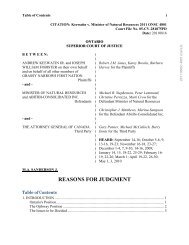COURT OF APPEAL FOR ONTARIO
COURT OF APPEAL FOR ONTARIO
COURT OF APPEAL FOR ONTARIO
You also want an ePaper? Increase the reach of your titles
YUMPU automatically turns print PDFs into web optimized ePapers that Google loves.
Page: 100<br />
is liable for direct damages caused to an adjacent property where a property owner<br />
excavates and interferes with the right of natural support of an adjacent property. They<br />
rely on Barber v. Leo Contracting Co. Ltd., [1970] 2 O.R. 197 (C.A.), for this theory of<br />
liability.<br />
[251] On the issue of damages, the appellants emphasize that there is no evidence to<br />
contradict their expert‟s report, which states that the failure to take precautionary<br />
measures during the excavation resulted in damage to their properties as described in the<br />
report. The appellants also argue that the quantum of damages is not seriously challenged<br />
and the new Rule 20 does not permit the respondents to rest on bald denials.<br />
5. Analysis<br />
(1) How should Rule 20 be applied in the context of an action under Rule<br />
76?<br />
[252] As indicated, the appellants brought their motion just as significant changes to the<br />
rules related to simplified procedure and summary judgment were being implemented.<br />
Under the now-revoked rule 76.07, the motion judge had broader powers than did a judge<br />
hearing summary judgment motions under the former Rule 20. Under rule 76.07, a judge<br />
was allowed to make determinations of fact including determinations of credibility: see<br />
Newcourt Credit Group Inc. v. Hummel Pharmacy Ltd. (1998), 38 O.R. (3d) 82 (Div.<br />
Ct.), at p. 86. The motion judge was to grant summary judgment unless the judge was
















